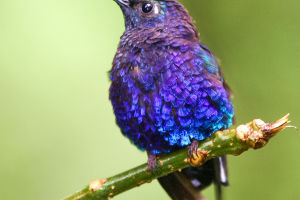Charming Lovebirds
With the gradual popularization of birding culture, the activity of birding has become increasingly popular and accessible to the general public.
As a result, the sight of pet birds, including peach-faced lovebirds, has become more common. Today, let's take a closer look at these delightful creatures!
The peach-faced lovebird, scientifically known as Agapornis roseicollis, is a species of lovebird native to the arid regions of southwestern Africa. It is highly sociable and tends to gather in flocks. In the wild, these birds usually form small groups of about ten individuals.
Both males and females are highly family-oriented. However, when bred in captivity, peach-faced parrots develop a strong bond with humans. They enjoy being tickled and often perch on people's hands, arms, and heads. With their lively personality and innate curiosity, they are always eager to explore new things.
Peach-faced lovebirds primarily inhabit dry woodlands in regions below 1500 meters in altitude. They can be found in various environments ranging from dry grasslands in sub-desert zones to tropical grasslands.
These birds tend to stay near water sources and often move in groups of around 5 to 20 individuals. However, during feeding and drinking times, hundreds of peach-faced lovebirds may gather at the same water source. Unfortunately, in many areas, they are considered pests and can cause significant damage to crops.
During colder weather, several birds may roost together on branches. They typically nest in rock crevices or take over the nests of other bird species.
In terms of appearance, peach-faced lovebirds have predominantly green body. They have thin, narrow stripes of red feathers on their foreheads and behind their eyes. Their heads display pink coloring on the top, between the beak and eyes, on the cheeks, throat, and above the chest.
The sides of their bodies, bellies, and inner tail coverts have a yellow-green hue, while their tails are bright blue on the outside and green with blue on the inside. The inner wing coverts showcase a mix of green and light blue, and they have yellow-white beaks and dark brown irises.
Juvenile peach-faced lovebirds have a black beak and a grayish-pink head. It takes approximately four months for them to acquire the vibrant colors of adult plumage.
Among the lovebird species, the peach-faced lovebird is the largest, slightly shorter in length than the black-winged lovebird parrot but with a greater weight. There are various color mutations of peach-faced lovebirds, making them one of the most popular choices for beginners in bird ownership.
Since peach-faced lovebirds raised by hand from an early age have a strong bond with their owners, they enjoy human interaction. Some individuals may even exhibit mischievous behavior and quick movements, which can make them elusive and prone to escaping if not carefully handled.
To prevent them from flying away, some owners opt to trim their feathers, reducing the likelihood of escape.
It's important to note that the body temperature of a peach-faced lovebird is higher than that of a human, typically ranging from 38.3 to 39.4 degrees Celsius. Therefore, the temperature of their food should be close to their body temperature to ensure they eat it. If their food is too cold, they may refuse to eat.
Peach-faced lovebirds are captivating birds with their striking colors and sociable nature. Their popularity as pets continues to grow due to their affectionate behavior towards humans. With proper care and attention, these little parrots can make wonderful companions for bird enthusiasts of all levels of experience.


